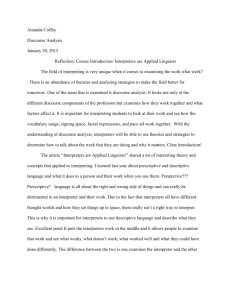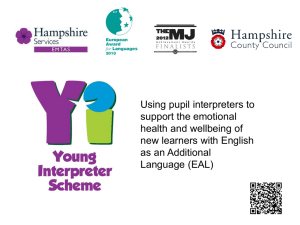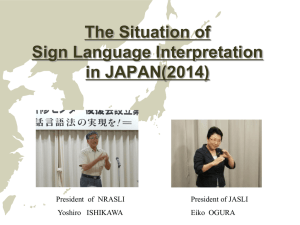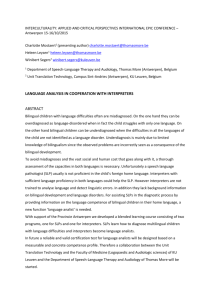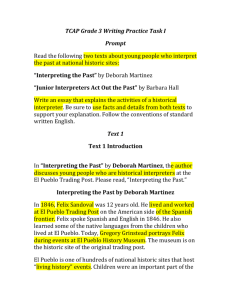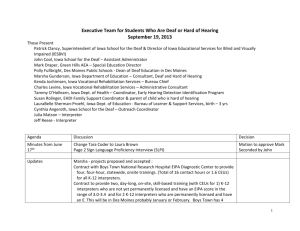iswoopexecsum92115
advertisement
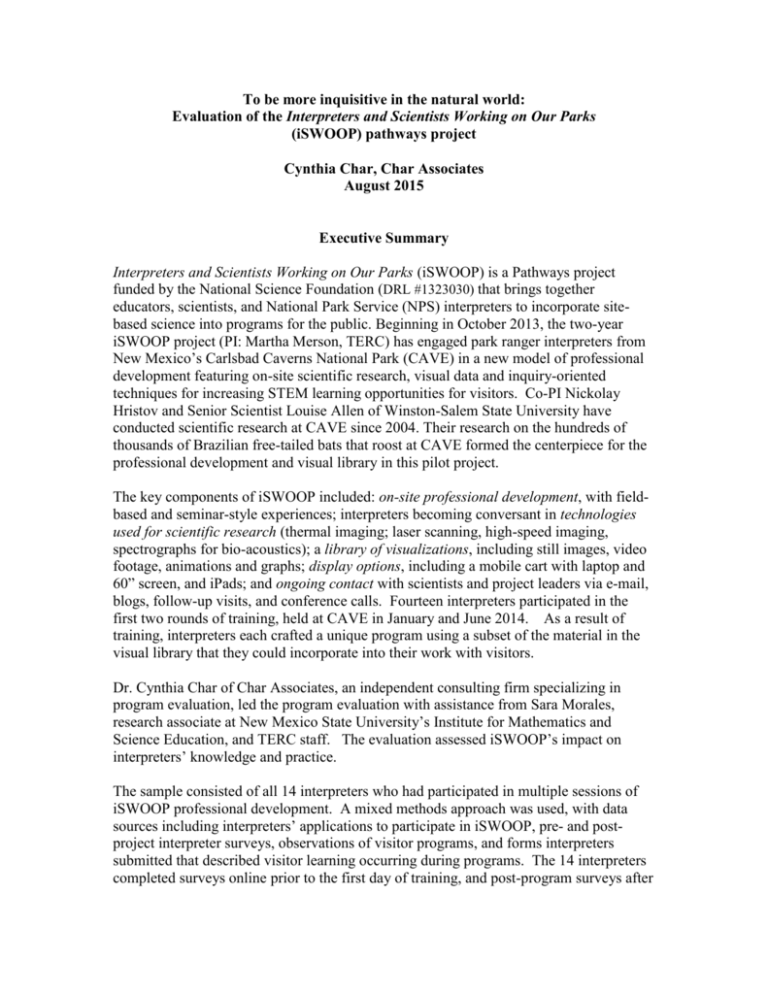
To be more inquisitive in the natural world: Evaluation of the Interpreters and Scientists Working on Our Parks (iSWOOP) pathways project Cynthia Char, Char Associates August 2015 Executive Summary Interpreters and Scientists Working on Our Parks (iSWOOP) is a Pathways project funded by the National Science Foundation (DRL #1323030) that brings together educators, scientists, and National Park Service (NPS) interpreters to incorporate sitebased science into programs for the public. Beginning in October 2013, the two-year iSWOOP project (PI: Martha Merson, TERC) has engaged park ranger interpreters from New Mexico’s Carlsbad Caverns National Park (CAVE) in a new model of professional development featuring on-site scientific research, visual data and inquiry-oriented techniques for increasing STEM learning opportunities for visitors. Co-PI Nickolay Hristov and Senior Scientist Louise Allen of Winston-Salem State University have conducted scientific research at CAVE since 2004. Their research on the hundreds of thousands of Brazilian free-tailed bats that roost at CAVE formed the centerpiece for the professional development and visual library in this pilot project. The key components of iSWOOP included: on-site professional development, with fieldbased and seminar-style experiences; interpreters becoming conversant in technologies used for scientific research (thermal imaging; laser scanning, high-speed imaging, spectrographs for bio-acoustics); a library of visualizations, including still images, video footage, animations and graphs; display options, including a mobile cart with laptop and 60” screen, and iPads; and ongoing contact with scientists and project leaders via e-mail, blogs, follow-up visits, and conference calls. Fourteen interpreters participated in the first two rounds of training, held at CAVE in January and June 2014. As a result of training, interpreters each crafted a unique program using a subset of the material in the visual library that they could incorporate into their work with visitors. Dr. Cynthia Char of Char Associates, an independent consulting firm specializing in program evaluation, led the program evaluation with assistance from Sara Morales, research associate at New Mexico State University’s Institute for Mathematics and Science Education, and TERC staff. The evaluation assessed iSWOOP’s impact on interpreters’ knowledge and practice. The sample consisted of all 14 interpreters who had participated in multiple sessions of iSWOOP professional development. A mixed methods approach was used, with data sources including interpreters’ applications to participate in iSWOOP, pre- and postproject interpreter surveys, observations of visitor programs, and forms interpreters submitted that described visitor learning occurring during programs. The 14 interpreters completed surveys online prior to the first day of training, and post-program surveys after interpreters had at least ten weeks in which to implement iSWOOP visitor programs. Observers took ethnographic field notes during 26 iSWOOP programs for visitors. Using their field notes, observers scored the interpreters’ programs on four major dimensions: 1) park-based research questions and findings; 2) scientific content related to bat behavior; 3) use of technology and images; and 4) visitor interaction techniques. Comment boxes and questions on the forms interpreters completed after delivering their programs asked specifically for impressions and quotes related to visitor learning. Interpreters recorded visitor responses to variations of two questions: “Did you see something in a new way?” and “Who found out something new about scientists’ work?” and asked visitors to volunteer examples of what they had learned. The interpreters submitted comments on 104 program sessions with a total of 1067 visitors in the project’s first nine months. FINDINGS iSWOOP increased interpreters’ knowledge and understanding of park-based scientific research Greater Access to Pertinent Scientific Research and Scientists. Information needs are significant for park interpreters, who often search for park-related scientific information weekly. They tend to rely most on the Internet and on materials prepared by others for use in the park, and to a slightly lesser extent, journal articles. They generally viewed their information searches as successful. Another way to learn about park-based science is through direct contact with scientists. In the experience of these interpreters, such opportunities were quite rare, with low frequency of various kinds of contact (e.g., public lecture; briefing sessions; guided tours; participating in actual data collection; regular ongoing exchanges with scientists.) Thus, iSWOOP offered a rarely utilized form of contact and collaboration between park interpreters and scientists conducting on-site research. By delivering direct contact with scientists, iSWOOP project activities increased interpreters’ understanding, first-hand experience, and enthusiasm about on-site scientific research happening at their parks. Increased Scientific Knowledge. At the beginning of iSWOOP, interpreters rated their ability to convey scientific content knowledge related to the bats of Carlsbad Caverns. The specific areas in which they saw themselves as least adept were the scientific bat research conducted at CAVE, bat behavior patterns, and fluctuations in bat body temperature related to bat activities. Interpreters also described modest levels of being able to make sense of images from technology (e.g., thermal cameras, laser scans and high speed videography). Following iSWOOP training, interpreters reported improvements in their ability to convey a variety of scientific topics to visitors. Some of the areas in which interpreters reported improvements were ones that they had earlier indicated already having high levels of prior knowledge. The greatest gains were for making sense of images from technology, and the sense of 3D spaces of the caverns both major emphases in the iSWOOP training. Interpreters also reported sizeable improvements in their understanding of the scientific bat research being conducted at CAVE and the ways Brazilian free-tailed bats interact with their habitat. Observations and interpreters’ visitor learning forms corroborated that interpreters were putting new knowledge into practice: conveying to visitors scientific content pertaining to bats and park-based research, the science process, and the technology used to study bats. iSWOOP Enhanced Interpreters’ Pedagogical Strategies for Engaging the Public Prior to iSWOOP, most interpreters felt their pedagogical skills were strong. They gave themselves high ratings in such areas as involving visitors in making observations, generating excitement, and providing opportunities for visitors to build on ideas. The main area that they deemed as weak was incorporating scientists’ graphs and high-tech visuals into programs. Following iSWOOP professional development and an opportunity to try out the mobile cart and visual library with visitors, interpreters reported the greatest improvements in incorporating scientists’ graphs and high-tech visuals into their programs. They also noted improvements in their ability to generate excitement and involve visitors in making observations. Although these were skills on which they had earlier given themselves positive ratings, iSWOOP expanded their skillset. Close to half the interpreters cited the inquiry-oriented and participatory visitor approach encouraged in iSWOOP as the greatest benefits of the program. Most interpreters also reported that iSWOOP had enabled them to look at visitor engagement differently, and that they are now more actively seeking to engage visitors in conversation, rather than delivering a more one-way exchange. Interpreters stated that iSWOOP had helped them better engage visitors in the ongoing research occurring at their park and for conveying the process of doing science, including researchers’ applications of cutting-edge technology. Observations corroborated that interpreters were actively engaging visitors during their programs, eliciting visitor participation, involving visitors in making observations and predictions, and soliciting questions from visitors. Almost all sessions observed scored at medium or high levels of overall visitor engagement and visitor interactivity. iSWOOP Viewed as a Valuable Professional Development Experience by Interpreters All of the interpreters reported that they had found participating in iSWOOP valuable. The benefits that interpreters most often mentioned concerned the access to scientific research being conducted at the park and the technology and data visualizations used by scientists, and the inquiry-oriented and participatory visitor approach encouraged in iSWOOP. The elements of iSWOOP that interpreters reported as especially valuable were the onsite professional development, the suggested readings, and the e-mailing with project leaders. The two technology formats – large screen monitor and computers, and iPad – were positively received, and each seen as useful in different ways, depending on the format of visitor program and interaction. Interpreters recommended that the program need to provide adequate time and support to enable interpreters to become sufficiently comfortable and adept at using the technology in their programs. When discussing the biggest challenges of incorporating science research into their visitor programs, interpreters at first focused on their personal difficulties accessing scientific research as well as raised questions about appropriate techniques to foster visitor engagement and inquiry. Towards the end of iSWOOP professional development, interpreters expressed fewer concerns about their own access to information. Instead, their comments revealed a heightened awareness of techniques appropriate for engaging visitors with scientific research. In summary, as implemented at CAVE, the iSWOOP program offered a unique form of contact and collaboration between on-site park interpreters and scientists conducting onsite research rarely offered in National Parks. Through professional development experiences spanning both classroom seminars and field-based sessions with scientists, interpreters acquired a range of new visual tools (a library of scientific visualizations and images) and questioning strategies to encourage visitors to make sense of scientists’ visualizations. These components were highly valued by interpreters, and offer a strong foundation of program elements that should continue to be included in future iSWOOP programs. Moreover, the pilot study indicates that the iSWOOP training and approach were successful in increasing interpreters’ understanding, first-hand experience, and enthusiasm about on-site scientific research happening at their park, and also in increasing interpreters’ pedagogical awareness and skills to foster more active, inquisitive visitor engagement in science. Interpreters were seen putting knowledge into practice through their programs, and visitors reported acquiring new knowledge relating to bats, park-based research, the science process, and the technology used to study bats. The pilot study suggests that iSWOOP offers a promising and effective professional development model for the National Park Service as it strives to encourage lifelong learning and science literacy among its park visitors. For further information on the study, contact: Dr. Cynthia Char Char Associates 147 Connor Road Montpelier, VT 05602 www.charassociates.com


